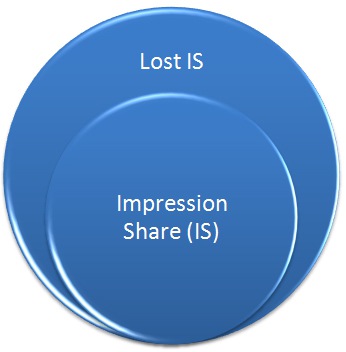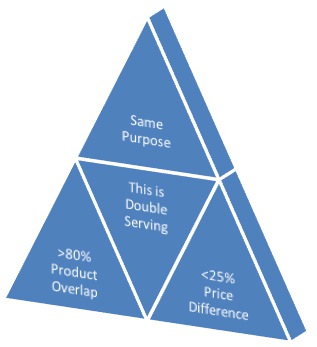Last week I discussed how to maximize PPC impressions for advertisers with unlimited budgets who want to reach as many good prospects in their niche as possible. (“5 Ways to Maximize PPC Impressions”)
Maximum Impression Share versus Lost Impressions
To maximize impressions, you also should look at your Exact Match IS to see what percentage of your impressions are coming from keywords NOT in your account. Get that by subtracting Exact Match IS from 100%. Then run a campaign report on all campaigns and check for Lost IS due to budget or rank. This will help you see whether you’re missing impressions due to campaign budgeting or to Ad Rank issues. In the latter case, you’ll need to either bid more, or improve CTR with account structure optimization and ad copy tests.

Once you’ve conquered that problem, your next problem is having reached the limit of impressions that any one account can get.
No single PPC account can get 100% of the impressions in any niche. Only ad per account will show for any one keyword search at a time.
How to Safely Go Beyond the Limits of One AdWords Account
An aggressive advertiser wants to be seen for 100% of searches for the keywords that get them the ROAS they want. And the only way to do this is with more AdWords accounts that use those same keywords. However, you must not violate AdWords’ Double Serving Policy, if you don’t want to risk getting shut down.
AdWords defines Double Serving as
Displaying more than one ad for the same company or person at a time.
But there are exceptions that will allow you to get more impressions within regulations.
In cases like our client, where more than one company is involved and a variety of products and price points, the following general parameters were offered by our AdWords Dedicated Support Team:
You are welcome to split up your separate business entities among different accounts. We consider websites to be double serving if they have the same purpose, over 80% product overlap, AND less than 25% price difference. As long as your websites steer clear of this criteria, you are welcome to set them up in whatever format is most convenient for you.

Creating Multiple Sites to Get More Impressions While Avoiding the Three Strikes of Double Serving
Disclaimer: our AdWords rep was very clear that these are reviewed case-by-case. There’s no guarantee that you’ll be approved if you heed these criteria. But it gives you a much better shot.
Let’s get out our lawyer hats, take this apart, and see how we can use it.
Note that the policy uses the word “AND” for the three criteria. You have to violate all three to get in trouble.
Websites should not have the:
- Same purpose
- >80% product overlap AND
- <25% price difference
Purpose: Purpose is vague- but let’s assume you are selling cell phones on all three sites, and that’s the same purpose. You’d still have to violate the other two criteria to be double serving.
Product Overlap: Are the products 80% similar on the two sites? Oops, two strikes- one more and you’re out. Why not instead divide up your cell phones into two or three types, or by manufacturer?
One site per type, or one site per manufacturer.
Price Difference: If you do have two cell phone store websites with the same products, then one of the sites has to be a discount site to not violate the price difference criterion.
To take the safest route, create multiple websites with less than 80% product overlap and more than 25% price difference. If you can, make one site for sales and one for leads- that might also help you with the purpose criterion.
Ensuring That Prospects Accept Your New Websites
Like many strategies, this could be abused. Don’t be black hat. It won’t serve you in the end anyway, because your offering on every website has to appeal to the prospect that searches for your keywords. If the offer (ad) doesn’t fit the searcher mindset, though you may get good CTR with clever ads, your conversion rate will suffer and the overall effort won’t deliver good ROI.
While conceiving these new websites, think through the entire sales process from keyword to conversion. You’re trying to place more relevant ads for the same keyword searches, so make sure the offer you’ll have to present for these new sites will be appealing to your prospects.
This strategy is best for more general keyword searches, so you’ll need to divide website concepts in a way that doesn’t make their offerings too granular and specific for general keyword searches.





